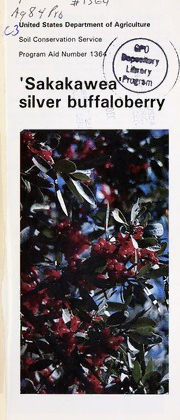
'Sakakawea' silver buffaloberry PDF
Preview 'Sakakawea' silver buffaloberry
Historic, Archive Document Do not assume content reflects current scientific knowledge, policies, or practices. r ^United States Department of Agriculture S Soil Conservation Service Program Aid Number 136/' / 'Sakakawea^ silver buffaloberry 'Sakakawea' silver buffaloberry 'Sakakawea' silver buffaloberry {Shepherd/a Branches are spiny and have gray-brown bark. argentea [Pursch] Nutt.) is a large shrub with The leaves are opposite, simple, and oblong. silvery, oblong leaves and predominantly red They are 1 to 2 inches long and 1/4 to 3/8 inch fruit. It is winter hardy and drought and alkali wide. Both surfaces are covered with silvery tolerant. scales, and side veins are indistinct. Sakakawea is highly recommended for Male and female flowers grow on separate revegetation of surface mined lands, plants. They bloom in April and are clustered transportation and transmission corridors, flood on short spur branches or scaly stalks. plains, and other disturbed areas. It is also recommended for the outside rows of farmstead The dry, thin-walled fruit ripens in September windbreaks and multirow field windbreaks and and is 1/8 to 1/4 inch in diameter. The fruit is for wildlife habitat plantings. Mule deer browse predominantly red, but 12 to 20 percent of the stems and twigs, and grouse and songbirds female plants produce yellow fruit. eat the fruit. Sakakawea silver buffaloberry originated from Sakakawea was released in 1983 by the Soil open-pollinated seed collected in 1954 from the Conservation Service (SCS) in cooperation with cultivar 'Goldeye' at the Canadian Department the State Agricultural Experiment Stations of of Agriculture's Research Station, Morden, Minnesota, North Dakota, and South Dakota. Manitoba. Seedlings used for advanced testing were established at the SCS Plant Materials Center in Bismarck, North Dakota. Description On favorable soils, Sakakawea silver Adaptation buffaloberry reaches a mature height of 1 2 to 16 feet in 1 5 to 20 years. Crown width is 16 Sakakawea is primarily adapted in the area of to 19 feet. Sakakawea spreads by sucker the northern Great Plains shown on the map. growth and can form a dense thicket. It fixes It performs well on soils that are in the SCS nitrogen via root nodules. Windbreak Suitability Groups 1-5. These soils are deep or moderately deep, well to somewhat poorly drained, and fine to moderately fine textured. Avoid planting it on soils that are coarse textured, extremely saline, or droughty. Sakakawea is winter hardy where the average annual minimum temperature ranges from -40 to -20 degrees F (hardiness zone 3a-4b). Mean survival ranges from 60 to 95 percent under field conditions. Establishment and rate of growth are affected by weed competition, j shade, drought, and adverse soil conditions. I Seed production is good to excellent in most years. In performance, Sakakawea is equal or superior to common silver buffaloberry. It was j selected for conservation uses because of its I uniform growth and good to excellent stand establishment, survival rate, and seed i production. It has no apparent insect problems. Establishment Cultivate the site and keep it fallow for at least 1 year before planting Sakakawea seedlings. Plant the seedlings in spring as soon as the ground thaws, when soil moisture is high. Recommended spacing in the row is 3 to 5 feet. Use 2-year-old seedlings that are 12 to 24 inches tall and have stem diameter of 3/16 to 1/2 inch just above the root collar. One-year- old seedlings that reach this height and diameter are also suitable. Control weeds by mechanical cultivation or recommended herbicides for a minimum of 5 years. Sakakawea forms a solid stand and begins producing fruit in 3 or 4 years. Propagation Propagate Sakakawea from seed. Mature fruit can be collected in September and processed by wet maceration. Store the seed under cool, dry conditions. Seed can be planted in fall or spring. For spring planting, stratify the seed for 90 days in damp sand at 41 degrees F. Plant 30 to 50 seeds per linear foot of row, and cover with 1/4 inch of soil. Availability The SCS Plant Materials Center (P.O. Box 1458, Bismarck, ND 58502) maintains breeder seed and foundation stock of Sakakawea silver buffaloberry. Certified seed is available from growers approved by your State certified seed department. For more information on availability and use of Sakakawea silver buffaloberry, contact your local SCS office. It is listed in your telephone directory under "U.S. Government, Department of Agriculture." TheUnitedStatesDepartmentofAgriculture(USDA)prohibits discriminationinitsprogramsonthebasisofrace,color,nationalorigin,sex, religion,age,disability,politicalbeliefsandmaritalorfamilialstatus. (Notall prohibitedbasesapplytoallprograms). Personswithdisabilitieswhorequire alternativemeansforcommunicationofprograminformation(braille,largeprint, audiotape,etc.)shouldcontacttheUSDAOfficeofCommunicationsat(202) 720-5881 (voice)or(202)720-7808(TDD). Tofileacomplaint,writetheSecretaryofAgriculture,U.S.Department ofAgriculture,Washington,D.C.20250,orcall(202)720-7327(voice)or(202) 690-1538. USDAisanequalemploymentopportunityemployer. Reviewed, Revised and Approved for Reprinting September 1994 March 1985
